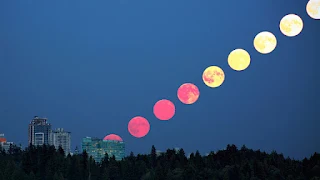-
Sky watchers are preparing to receive a rare astronomical phenomenon that occurs every 18 years, and is called the “major lunar standstill.”
Sky watchers are preparing to receive a rare astronomical phenomenon that occurs every 18 years, and is called the “major lunar standstill.”
The "Great Lunar Recession" occurs only once every 18.6 years, when the moon's rising and setting reach the furthest north and south points from the sun along the horizon, as seen from Earth. This is possible because the Moon does not follow the same path as the Sun, so the positions of its rising and setting on the horizon are constantly changing due to the movement of the Earth and the Moon.
The last similar event was in 2006, and according to scientists, the causes of the “Great Lunar Recession” are very complex, but ultimately they are related to the angle between the Moon and the celestial equator (its declination). The moon usually rises and sets in approximately the same place. However, when lunar stasis occurs, the moonrise and sunset at its northernmost point and its southernmost point are far apart from each other, and that is when the inclination of both the Earth and the Moon is at its greatest. During this period, the moon rises and sets at its maximum extent.
To clarify, during the “Great Lunar Recession” phenomenon, the moon’s tilt fluctuates greatly, causing its sunrise and sunset to reach the furthest point from each other along the horizon.
In practical terms, this means that the moon will appear to move differently than normal. The points on the horizon, where it rises and sets, will be farthest north and south during the Great Lunar Recession. This explains why the moon sometimes rises and sets at points on the horizon farther north and south than the sun.
The "Great Lunar Recession" greatly affects how long the moon remains in the sky at night. The moon rises to the far northeast in the northern hemisphere, ascends to the sky and remains there for a longer period than usual.
In fact, this astronomical phenomenon does not occur in one day, but rather occurs over a period of time.
The “Great Lunar Recession” season will begin this year, as the moon’s declination becomes more extreme.
For sky watchers, the "stagnation" is expected to reach its maximum extent in late 2024 to mid-2025.
The best time to see the effects of the "recession" will be during the equinoxes in September 2024 and March 2025.
If you watch the moon regularly from the same location, you will be able to notice big changes in how it moves across the sky over the next few weeks and months, with the naked eye, without resorting to telescopes and binoculars.






It's rarest of the rare.
ReplyDeleteInformative
ReplyDeleteInformative
ReplyDelete